Novel interface engineering of LDH-based materials on Mg alloy for efficient photocatalytic systems considering the geometrical linearity of condensed phosphates
Mosb Kseem ,Annd Repych Sfir ,Arsh Ftth-lhosseini
a Department of Nanotechnology and Advanced Materials Engineering, Corrosion and Electrochemistry Laboratory, Sejong University, Seoul 05006, Republic of Korea
b Department of Materials Engineering, Bu-Ali Sina University, Hamedan 65178-38695, Iran
Abstract This study presents a facile and rapid method for synthesizing novel Layered Double Hydroxide (LDH) nanoflakes,exploring their application as a photocatalyst,and investigating the influence of condensed phosphates’ geometric linearity on their photocatalytic properties.Herein,the MgO film,obtained by plasma electrolysis of AZ31 Mg alloys,was modified by growing an LDH film,which was further functionalized using cyclic sodium hexametaphosphate (CP) and linear sodium tripolyphosphate (LP).CP acted as an enhancer for flake spacing within the LDH structure,while LP changed flake dispersion and orientation.Consequently,CP@LDH demonstrated exceptional efficiency in heterogeneous photocatalysis,effectively degrading organic dyes like Methylene blue (MB),Congo red (CR),and Methyl orange (MO).The unique cyclic structure of CP likely enhances surface reactions and improves the catalyst’s interaction with dye molecules.Furthermore,the condensed phosphate structure contributes to a higher surface area and reactivity in CP@LDH,leading to its superior photocatalytic performance compared to LP@LDH.Specifically,LP@LDH demonstrated notable degradation efficiencies of 93.02%,92.89%,and 88.81% for MB,MO,and CR respectively,over a 40 min duration.The highest degradation efficiencies were observed in the case of the CP@LDH sample,reporting 99.99% for MB,98.88% for CR,and 99.70% for MO.This underscores the potential of CP@LDH as a highly effective photocatalyst for organic dye degradation,offering promising prospects for environmental remediation and water detoxification applications.
Keywords: Plasma electrolysis;Layered Double Hydroxide;Condensed phosphates;Adsorption capacity;Photocatalytic efficiency.
1.Introduction
Heterogeneous photocatalysis has emerged as a promising approach for the degradation of organic pollutants in water[1].Photocatalytic processes utilize semiconducting materials to absorb light energy,generating reactive species that can break down organic compounds into harmless byproducts[2].Among various photocatalysts,Layered Double Hydroxides (LDHs) have garnered considerable attention due to their unique properties,tunable compositions,and exceptional photocatalytic capabilities [3–5].Because of their many favorable attributes,such as minimal toxicity,a low energy band gap,a large specific surface area,cost-effectiveness,easy preparation,chemical stability,layered structure,and effective charge separation ability,LDH materials have become a highly preferred option for semiconductor photocatalysis.
The general formula for LDH is [M2+1-xM3+x(OH)2]x+An-x/n.H2O,where M2+and M3+represent divalent and trivalent cations forming brucite-like sheets,while An-denotes anions positioned between the layers with H2O [6].LDH’s chemical composition can be tailored,allowing consistent distribution of multiple cations within the interlayer without segregation.Moreover,the interlayers of LDH materials allow for the intercalation of various types of anions,and the particle size distribution can be adjusted to meet the specific requirements of diverse applications [7–10].Due to their unique layered morphology,LDHs offer distinct advantages in photocatalytic performance compared to other photocatalytic materials.These benefits include excellent adsorption capacity,enhanced light absorption efficiency,and moderate stability [3].Moreover,LDHs belong to the subclass of the anionic clay family,characterized by their two-dimensional layered nanomaterial structure.The peculiar layered arrangement of LDHs enables hybrid bonding with exceptional nanomaterials and the ability to exfoliate within polymer matrices,making them versatile for various applications.LDHs possess exceptional qualities that render them highly desirable for a diverse range of applications,particularly in the adsorption and treatment of organic contaminants,with a specific emphasis on organic dyes [11].Researchers are actively exploring these remarkable attributes to develop efficient procedures for the removal and treatment of organic pollutants utilizing LDHs.For example,Shao and colleagues [12]prepared Zn-Ti LDH(3:1) and achieved 100% photodegradation of methylene blue(MB) within 100 min,thanks to its lower band gap (3.06 eV)compared to ZnO and TiO2catalysts.Asif and co-workers[13]successfully fabricated graphene oxide/Co-Al LDH composite via the co-precipitation method.The prepared catalyst degraded MB with an efficiency of ∼71% after 60 min of exposure to UV irradiation.However,a significant challenge faced by LDHs is the inefficient separation of photogenerated charges,hindering their photocatalytic performance [13].For this reason,a novel approach to modifying LDH materials is needed to achieve high photocatalytic performance.
Condensed phosphates,as a class of chemical compounds formed by the condensation of multiple phosphate units,possess distinctive geometric linearity,setting them apart from alternative phosphates [14].This unique geometric characteristic plays a pivotal role in determining their efficacy for enhancing the photocatalytic performance of the Mg alloy when incorporated into the surface oxide layer.Unlike other phosphate compounds,condensed phosphates offer an exceptional advantage due to their versatile and elongated structural configuration,which allows for more extensive interaction with the surface and reactants.This unique structural feature enhances the catalyst’s ability to facilitate surface reactions,making condensed phosphates a compelling choice for improving the photocatalytic properties of materials,such as Mg alloys [15].
The main objective of this study,therefore,is to explore how the geometrical linearity of condensed phosphates impacts the photocatalytic performance of LDH nanoflakes.The investigation focuses on the degradation of three representative organic dyes: MB,Congo red (CR),and Methyl orange (MO).The utilization of cyclic and linear condensed phosphates as modifiers aims to optimize the photocatalytic properties of LDH nanoflakes,enhancing their efficiency in organic dye degradation under UV light exposure.By understanding the influence of condensed phosphate modification on LDH nanoflakes’ photocatalytic activity,this research contributes to the development of advanced and scalable photocatalytic coatings for water detoxification applications.
2.Experimental details
2.1. Preparation of MgO and LDH films
The AZ31 Mg alloy substrate was subjected to an electrochemical treatment to create a MgO film,which is an inorganic porous layer.AZ31 Mg alloy was taken as the substrate of interest as the oxides of Mg are beneficial for multiple applications [16].All chemicals used in this work were high-purity and supplied by Duksan Chemical,Korea.The process involved applying a current density of 100 mA/cm2for 600 s using an electrolyte containing 4 g/L KOH and 10 g/L NaAlO2.The Layered LDH film was deposited onto the surface of the MgO layer using the NO3anion and a Mg2+/Al3+ratio of 2:1.The synthesis process involved gradually adding a 2 M NaOH solution to a mixture of 100 mL of 0.02 M Mg(NO3)2and 0.01 M Al(NO3)3solutions.The pH level was maintained at 10.5,and this addition was performed at a temperature of 323 K while being stirred using an electromagnetic field.Subsequently,the MgO film was immersed in the solution and kept submerged for 360 min at a temperature of 423 K.After the immersion,the film samples were taken out,carefully cleaned with ethanol,and left to air dry in a room-temperature environment.The method described above results in the formation of the LDH.
2.2. Modification of LDHs with condensed phosphates
LDHs films were immersed in two different solutions: one containing 0.1 M Na5P3O10(LP) with a pH of 9 and the other containing 0.1 M Na6P6O18(CP) with a pH of 7.5.The immersion process took place for 120 min at 333 K,aiming to investigate the impact of the geometric linearity of condensed phosphates on anion exchange reactions.This led to the formation of two distinct products: CP@LDH and LP@LDH,each with unique properties resulting from the specific phosphate used.Following the immersion,the modified films (CP@LDH and LP@LDH) were dried and washed with distilled water to ensure the removal of any impurities.The synthesis steps of CP@LDH and LP@LDH films on the surface of MgO film are described in Fig.1.
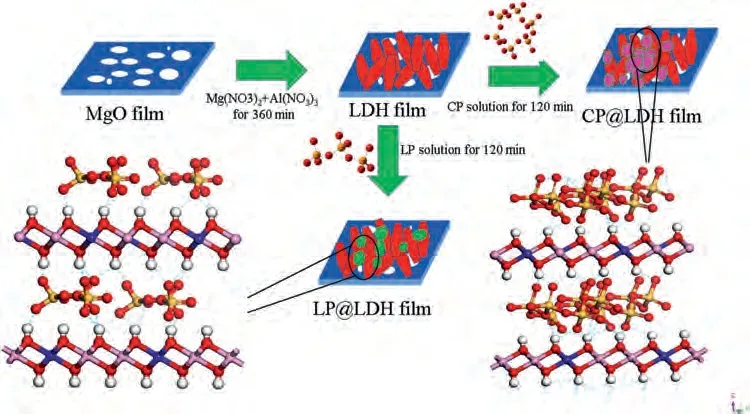
Fig.1.Schematic illustration showing the fabrication steps of CP@LDH and LP@LDH films.
2.3. Structural and compositional analysis
The morphologies of the prepared films were characterized using scanning electron microscopy (SEM-HITACHI,S-4800,Japan)equipped with an energy-dispersive spectrometer(EDS),and field-emission transmission electron microscopy(FE-TEM,Technai F20).The composition analysis of the films was performed using X-ray diffraction(XRD;RIGAKU,D-MAX 2500) and X-ray photoelectron spectroscopy (XPS,VG Microtech,ESCA 2000).The crystallographic structures of the PE film were previously analyzed in our prior study[17].In the present investigation,the crystallographic structures of the LDH film,both in its unmodified and modified forms,were characterized using XRD.The XRD analysis employed a step size of 0.05°and covered a scanning range from 5° to 30°.Furthermore,infrared spectra of the samples were recorded using FTIR-ATR spectroscopy (PerkinElmer Spectrum 100,USA),covering the wavenumber range of 650–4000 cm-1.
2.4. Photocatalytic activity
To evaluate the catalyst’s efficiency in the photocatalytic degradation of organic dyes,separate glass beakers containing freshly prepared solutions of MB(26.74 ppm),MO(61.09 ppm),and CR (28.70 ppm) were each placed with 2 cm x 2 cm samples of the catalyst.The dye solutions underwent photocatalytic degradation by being exposed to a 200 W UV lamp for 40 min,while 0.2 mL of a suitable initiator was added to facilitate the process.To assess the catalyst’s stability and reusability,the samples underwent multiple degrading procedures.Before being re-immersed in fresh dye solutions,the catalyst samples were meticulously cleaned using ethanol,DI water,and air drying to remove any residual contaminants.The degree of organic dye degradation was determined by observing the drop in absorbance,providing insights into the effectiveness of the catalyst in promoting the photocatalytic degradation of the organic dyes.The UV–vis spectrum was obtained using an Agilent Cary 5000 UV–vis spectrometer,USA.Each measurement was conducted in triplicate under consistent experimental conditions for reproducibility.
2.5. DFT calculations
Density functional theory (DFT) calculations of LP and CP anions were conducted using B3LYP functionals in GaussView 6.0.The study explored various molecular orbital energies (EHOMO/ELUMO),and HOMO-LUMO energy gap(ΔE) to investigate the adsorption and chemical reactivity of these anions on the surface of the PE coating [17,18].Additionally,GaussView 6.0 was used to visualize the electrostatic potential and molecular electrostatic potential after structure optimization.The charge transfer properties of the compound were examined through the analysis of the total density of states (TDOS) and projected densities of state (PDOS) spectra using Multiwfn and VMD software.Furthermore,the visualization of electron localization function (ELF) and reduced density gradient(RDG)was conducted using the Becke method with the same software.The calculations were performed over an energy range of -21.7691–5.4423 eV,and a DOS curve scale ratio of 2.7211 was used to ensure an accurate representation.
3.Results and discussion
3.1. Structural analysis
Fig.2 provides valuable insights into the morphology of the MgO film before and after modification by LDH films.In Fig.2(a),the original oxide coating on the AZ31 Mg alloy displays a porous structure which is typical for the coating produced via PE.These features can be attributed to the gas evolution that occurs during the PE process [19].The localized breakdown of the oxide layer due to microdischarges and sparks during PE leads to the formation of micropores.However,upon immersion in a solution containing Mg(NO3)2.6H2O and Al(NO3)3,an intriguing transformation takes place.As shown in Fig.2(b),a distinctive flake-like structure forms on the surface of the MgO film.The LDH structure,characterized by its unique flake-like morphology,is believed to arise from the electrochemical interactions between the substrate and the solution containing magnesium and aluminum ions.The presence of interconnected pores in the original oxide film likely facilitates the growth and attachment of the LDH flakes,resulting in the formation of a LDH network on the surface [20–22].The modification of the LDH film with CP and LP led to distinctive microstructural changes,as evident in the SEM images in Fig.2(c and d).CP,with its cyclic structure,interacts differently during LDH film growth.CP’s cyclic nature allows it to intercalate between the LDH layers,creating increased spaces between the flakes.As a result,the LDH flakes are more dispersed,leading to larger gaps between them and a distinctive flake-like structure forming on the film surface (Fig.2(c)).When LDH films are modified with LP,the linear structure of tripolyphosphate promotes a distinctive horizontal arrangement of the flakes during film growth.The straight chains of tripolyphosphate molecules align between the LDH layers,encouraging a compact stacking of the flakes and leading to a greater accumulation of flakes on the film surface.This arrangement imparts a unique flake-like LDH structure to the film.On the other hand,CP,with its cyclic structure,interacts differently during LDH film growth.CP’s cyclic nature allows it to intercalate between the LDH layers,creating increased spaces between the flakes.As a result,the LDH flakes are more dispersed,leading to larger gaps between them and a distinctive flake-like structure forming on the film surface.The contrasting effects of LP and CP modifications play a pivotal role in shaping the spacing and arrangement of the LDH flakes within the film.The EDS mapping analysis results presented in Table 1 indicated that the main elements present in all films were Mg,O,Na,and Al.Additionally,N and P elements were involved in the film formation during the LDH-based treatments.The presence of Mg,Al,O,and N elements could be attributed to the LDHs-NO3film,whereas P was incorporated into the LDHs film through the anion exchange reaction with either LP or CP.The amounts of P element incorporated in the case of CP@LDH film were higher than that in LP@LDH film which would suggest a better intercalation of CP anions with LDH.In line with the SEM images depicted in Fig.2(a–d),the TEM image presented in Fig.2(e) reveals a flake-like architecture for the CP@LDH film.Particularly noteworthy,the high-resolution TEM image shown in Fig.2(f) exhibits a lattice observation with a spacing of approximately 0.32 nm,corresponding to the (006) crystal plane of LDH.

Table 1 EDS mapping analysis on the surface of MgO,LDH,CP@LDH,and LP@LDH samples.
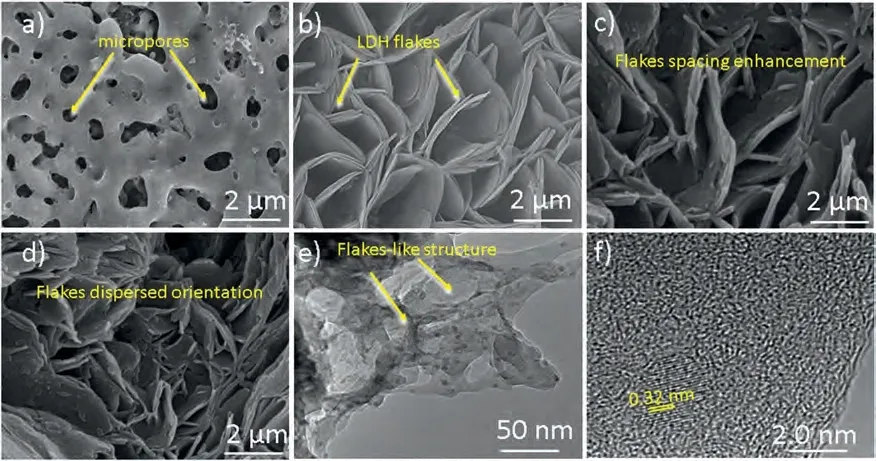
Fig.2.(a–d) SEM analysis on the surface of MgO,LDH,CP@LDH,and LP@LDH films,respectively.(e) Low magnification image showing the formation of the flake-like structure on the surface of CP@LDH film.(f) HR-TEM image of CP@LDH film.
The cross-sectional examinations were carried out to assess the morphological and thickness differences among the MgO,LDH,LP@LDH,and CP@LDH.Fig.3(a) shows the MgO film firmly bonding to the AZ31 Mg alloy substrate,with an average thickness of 8μm.Throughout the MgO film,a porous and rough microstructure is evident,with numerous interconnected pores,characteristic of the PEO process.After the formation of LDH,LP@LDH,and CP@LDH,distinct cross-sectional features can be observed,revealing hierarchical structures which cover the structural defects in MgO film.It is important to note that the formation of these films on the surface of the MgO film appears somewhat uneven,possibly due to partial distortion or crushing during the grinding and polishing processes [23,24].The thickness of the LDH film was found to be less than 1μm.EDS mappings in Fig.3(e and c) revealed the presence of Mg,O,Al,N,Na,and P elements in the cross-section of the CP@LDH film,and they exhibited random distribution over the hybrid film’s surface.The presence of the P element indicates active adsorption of the CP anions on the LDH surface.These findings provide compelling evidence of the successful incorporation of CP anions onto the LDH film,contributing to the unique hybrid structure and potential applications of the CP@LDH film.

Fig.3.(a–d) Cross-sectional images of MgO,LDH,CP@LDH,and LP@LDH films,respectively.EDS mappings of Mg,O,Al,Na,N,and P elements from the cross-section of CP@LDH film.
3.2. Compositional analysis
Fig.4(a) shows the FTIR spectra for LDH,LP@LDH,and CP@LDH samples.As shown in Fig.4(a),the analysis of the LDH film revealed two broad absorption bands at 3550 cm-1and 3690 cm-1,which were attributed to the stretching vibrations of OH-and H-O-H bonds.The wide and extended shape of these bands indicated the presence of water molecules that were hydrogen-bonded to the nitrate ions present in the interlayer of LDH [25].Furthermore,a band observed at 1380 cm-1indicated the presence of the antisymmetric stretching vibration of the NO3group [26,27].The characteristic sharp peaks observed at 1274.0,1095.3,879.6,and 474.2 cm-1can be attributed to the functional groups present in LP and CP [28,29].Specifically,the peak at 1274.0 cm-1corresponds to the asymmetric stretching frequencies of P=O,while the peaks at 1095.3 and 474.2 cm-1represent the P-O antisymmetric stretching vibration and symmetric variable angular vibration,respectively.Furthermore,the P-O-P symmetrical stretching vibration peak occurs at 879.6 cm-1[30].
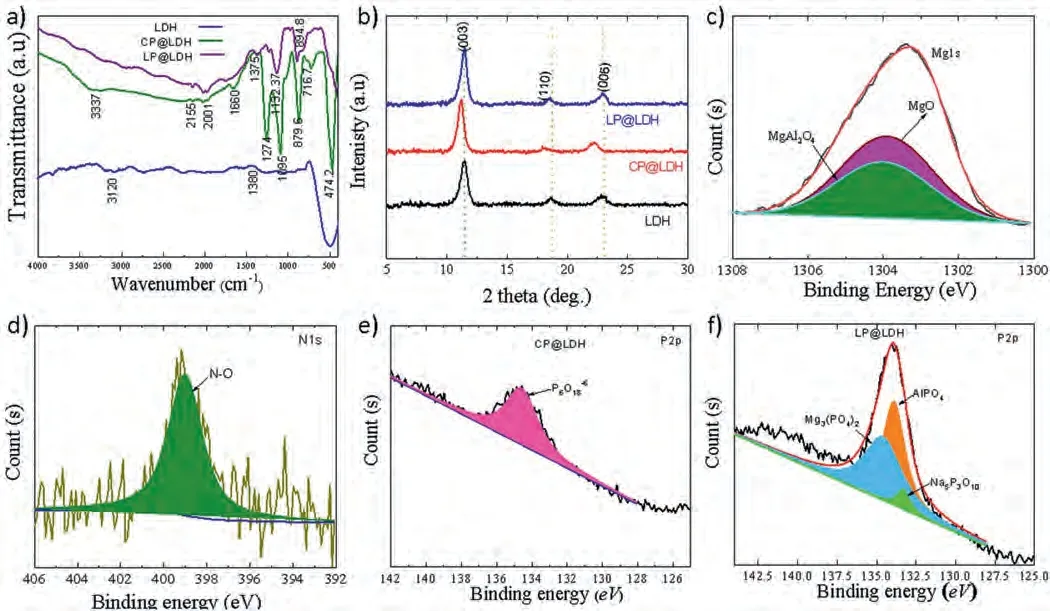
Fig.4.(a) FTIR spectra recorded for LDH,CP@LDH,and LP@LDH films.(b) XRD patterns of the LDH,CP@LDH,and LP@LDH films samples.(c-f)The high-resolution XPS spectra for (c) Mg 1s of MgO film,(d) N 1s of LDH film,(e and f) P2 P of CP@LDH and LP@LDH film,respectively.
Fig.4(b) shows the XRD patterns of LDHs (modified and unmodified) prepared on the surface of MgO film,with the angle range set between 5° and 35° (2θ).In a previous study,the composition of the PE film deposited on AZ31 Mg alloy using an electrolyte containing KOH and NaAlO2was identified as MgO and Mg2AlO4[17].Clear reflections corresponding to (003),(110),and (006) were observed around∼11.5°,∼18.6°,and ∼22.9° 2θ,respectively,indicating the formation of LDHs intercalated with NO3-ions (referred to as MgO-LDH film) Eqs.(1)–(3) [31,32].Upon the anionexchange reaction between LDH-NO3and cyclic/linear anions (CP and LP),the peak positions shifted towards lower 2θvalues,indicating successful intercalation of P6O186-and P3O105-anions into the film by displacing the NO3-anions in the LDH interlayer galleries.The formation of LDH,LP@LDH,and CP@LDH can be described as follows [1–7]:
The high-resolution XPS spectra for the elements Mg1s of MgO,N1s of LDH film,and P2p of CP@LDH and LP@LDH films are presented in Fig.4(c–f),respectively.The deconvolution of Mg1s for MgO film in Fig.4(c) indicated two peaks at 1303.9 and 1304 eV corresponding to MgO and Mg2AlO4,respectively.Following the XPS analysis,the N 1s spectrum of LDH film displayed a single peak at 400 eV,indicating the presence of the NO3group [23].The high-resolution P2p peak of the LDH modified by CP (CP@LDH film) exhibits a single peak located at 134.1 eV,corresponding to the PO3-group,which is associated with the metaphosphate group in CP (NaPO3)6Fig.4(e) [33–35].On the other hand,the highresolution P2p peak of the LDH modified by LP showed three distinct components at binding energies of 133.9 eV,134.6 eV,and 133.3 eV,corresponding to Mg3(PO4)2,AlPO4,and Na5P3O10,respectively [36–38].This suggests that LDH film tended to dissolve during the immersion in LP solution producing Mg2+and Al3+that react with PO43-generated from hydrolysis of P3O105-anions.The hydrolysis of P3O105-anions involves two distinct steps.Initially,the scission of the P-O-P linkage in LP leads to the formation of P2O72-ions.This process may involve the creation of an activated complex through chelation with water,H3O+ions,or hydrated metal ions [39].Subsequently,P2O72-ions undergo hydrolysis,resulting in the formation of PO43-ions(Eqs.(11)–((13)).The presence of a peak at 133.3 eV indicates that some LP might remain in the solution without undergoing complete hydrolysis.Consequently,the physical adsorption of P3O105-anions occurs,which is responsible for their incorporation into the LDH film.
The Eqs.(11) and (12) can be expressed as;
3.3. Photocatalytic performance
In this study,the degradation of MB,CR,and MO was investigated using a photochemical route with a UV-light source.Fig.5(a–l) presents a comparative analysis of the degradation of the dyes using different materials: MgO,LDH,CP@LDH,and LP@LDH.Focusing on the degradation of MB dye (Fig.5(a–d)),it was found that MB exhibited a distinct peak at approximately 664 nm in the UV-vis absorbance response.Over time,the intensity of this peak continuously decreased,indicating the sequential degradation of MB.When using the MgO film as the catalyst,a very slight degradation was observed over a 40 min period (Fig.5(a)).However,when the experiment was repeated with the synthesized LDH as the catalyst,a greater extent of degradation was observed,with the absorption peak intensity gradually decreasing over 40 min (Fig.5(b)).Interestingly,the MB dye in the case of CP@LDH sample (Fig.5(c)) was completely degraded within just 40 min of exposure time,demonstrating an ultra-fast photocatalytic dye degradation.As shown in Fig.5(d),significant and rapid degradation of MB was observed in the case of LP@LDH film compared to MgO and LDH samples.
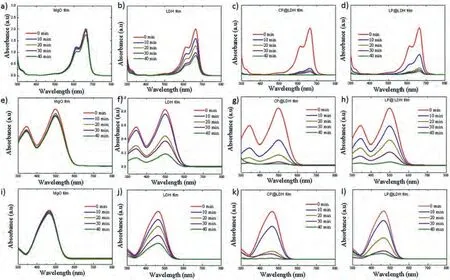
Fig.5.UV–vis absorbance profiles of MB (a-d),CR (e-h),and MO (i-l) solutions during degradation treatment in the presence of H2O2 initiator using MgO,LDH,CP@LDH,and LP@LDH films.
Fig.5(e–h) illustrates the degradation of CR solution in which CR exhibits a distinct peak at approximately 498 nm in the UV–vis absorbance response.When using MgO as the catalyst(Fig.5(e)),the degradation of the dye solution was minimal,similar to the results with MB.However,when LDH was used as the catalyst,a slight increase in degradation was observed,as shown in Fig.5(f).Upon treating an equal amount of dye solution with the same-sized catalyst (CP@LDH),the degradation rate remarkably accelerated,almost completely degrading the solution within just 40 min(Fig.5(g)).Notably,the LP@LDH sample showed even higher degradation than the MgO and LDH film but the efficiency was lower than that in CP@LDH film.The trend of dye degradation was similar for MO dye,showing a continuous decrease in the intensity of the prominent peak at 464 nm,indicating successful dye degradation.In comparison to other catalysts (Fig.5(i,j,and l)),the CP@LDH catalyst exhibited a much higher degree and faster rate of degradation under UV-illumination (Fig.5(k)).
The photocatalytic efficiency of the catalyst in dye degradation can be determined using Eq.(14).
The parameter Aorepresents the initial absorbance of each dye solution,while Atrepresents the absorbance of the dye solution at a specific time (t) during photocatalytic degradation.In Fig.6(a),the degradation efficiency of each dye is shown when treated with MgO,LDH,CP@LDH,and LP@LDH catalysts.MgO film exhibits limited degradation of dyestuffs with 40 min exposure to UV source.The degradation efficiency for MB,CR,and MO is only 12.43%,11.98%,and 7.06%,respectively.As for the LDH catalyst,the degradation efficiency was found to be 57.78%,76.75%,and 66.58% for MB,CR,and MO,respectively.However,the LP@LDH catalyst shows significantly higher degradation efficiency,reaching 93.02 % for MB,92.89 % for MO,and 88.81 % for CR over the same extended time of 40 min.The highest degradation efficiencies were found in the case of the CP@LDH sample where 99.99%for MB,98.88%for CR,and 99.70% for MO were reported.These results indicate that the CP catalyst effectively activates the initiator molecules into reactive [·OH]radicals compared to LDH and MgO.These[·OH]radicals then proceed to degrade the dyestuff.
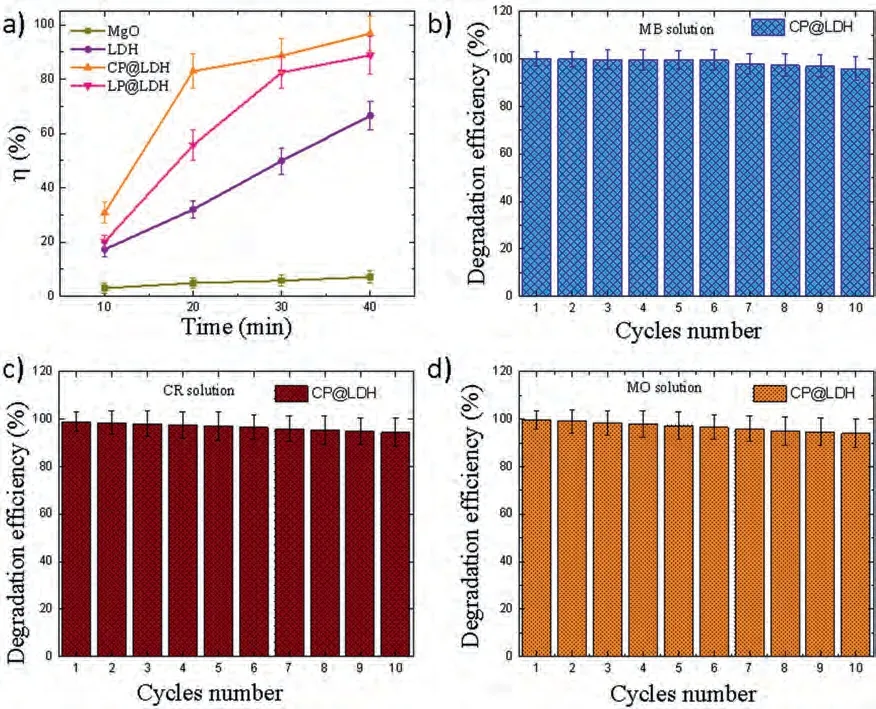
Fig.6.(a) Photocatalytic efficiencies of respective dyes using pristine MgO,LDH,CP@LDH,and LP@LDH catalysts.(b–d) Photodegradation efficiency of MB,CR,and MO solutions utilizing the CP@LDH catalyst over ten successive cycles.
The catalyst’s reusability was assessed for MB,CR,and MO dyes,and the results are depicted in Fig.6(b–d),respectively.For the reusability test,the catalyst underwent thorough washing with ethanol and D.I.water after each experiment.Subsequently,it was utilized in ten successive experiments.Although the catalyst demonstrated a slight decrease in efficiency after each cycle,this decline can be attributed to the successive washing,drying cycles,and potential handling variations of the samples.Despite the minor reduction in efficiency,the CP@LDH and LP@LDH retain their catalytic activity and remain reusable for multiple cycles,showcasing their effectiveness as new photocatalysts.
In other studies,Nayak et al.[40]investigated the efficacy of MgCr-LDH nanosheets in the photodegradation of MB,and they reported a photocatalytic efficiency of 90.6% after 2 h of exposure to solar light.Yang et al.[41]investigated the synergistic removal of a mixed solution containing methyl orange and sunset yellow using graded ZnCrNi-LDHs porous material.They reported a photocatalytic efficiency of 99.47% after 250 h of UV-light irradiation.Brahma and Sikia [42]synthesized ZrO2/MgAl-LDH composites and investigated their photocatalytic performance in the degradation of CR.After 90 min of exposure to UV light,the maximum dye removal efficiency of ZrO2/MgAl-LDH reached up to 97.19%.Megala et al.[43]employed LDH and CuWO4-based nanocomposites for the decomposition of MB.Among the prepared samples,LDH with 5% CuWO4achieved an 87.5% reduction in the initial MB concentration,while the photodegradation of MB without any catalyst under visible light illumination for five hours resulted in only a 19.8% reduction.In comparison,the CP@LDH catalyst displayed superior photocatalytic efficiency,outperforming some catalysts mentioned in the literature despite a shorter exposure time and a simpler preparation method.These results offer promising prospects for future applications in organic dye degradation.
3.4. Theoretical analysis
In assessing the adsorption capability of organic/inorganic molecules on a metallic surface,the gap energy (ΔE) serves as a significant parameter.SmallerΔE values are associated with higher reactivity [44–46].Based on the results in Fig.7(a),CP and LP anions exhibit differentΔE values,with LP demonstrating a lower value.This suggests that LP is likely to possess higher reactivity compared to CP,indicating its potential for enhanced adsorption on the LDH surface.While a lower energy gap is often associated with higher reactivity and better adsorption capabilities of anions/molecules on the LDH surface,it is not the sole determinant of their adsorption behavior.Other factors,such as molecular structure,surface chemistry,and electronic interactions,also play crucial roles.However,in the case of CP with a larger energy gap compared to LP,its better adsorption on the LDH surface might be attributed to the presence of a total negative charge in CP.This negative charge could lead to stronger interactions between CP and the LDH surface,enhancing its adsorption capability and photocatalytic properties despite its largerΔE.Thus,the role of negative charge in CP cannot be overlooked when considering its adsorption behavior on the LDH surface.
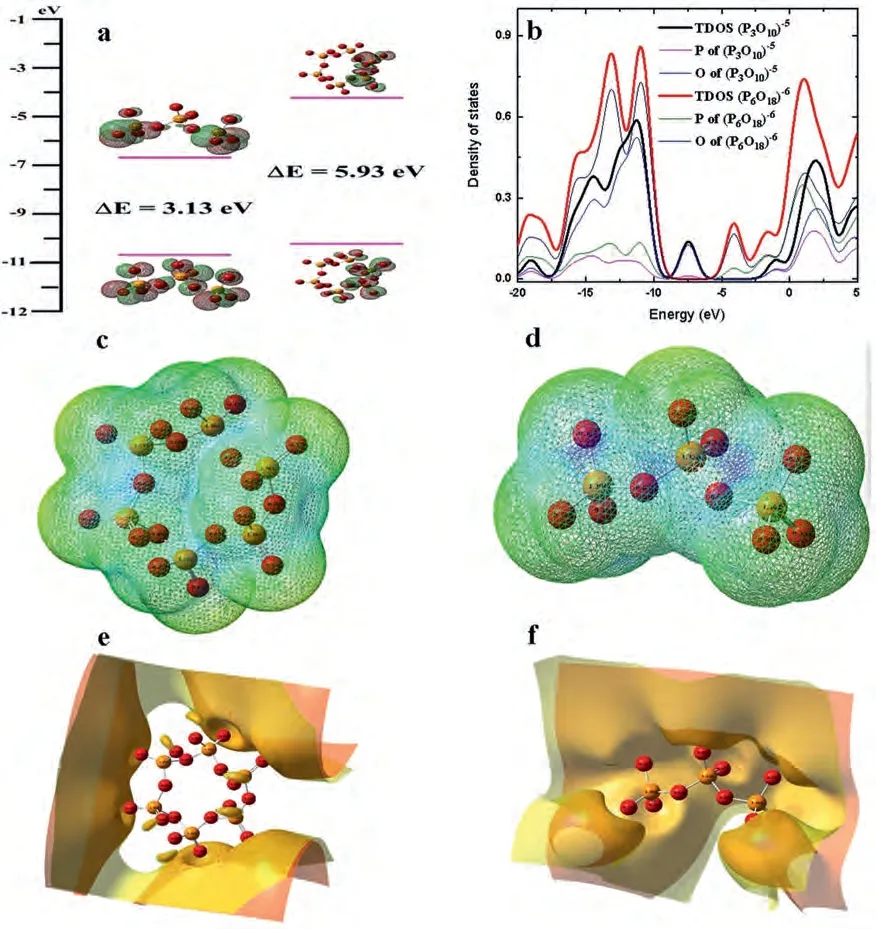
Fig.7.(a) HOMO-LUMO visualization,(b) DOS visualization,(c and d) MEP of CP and LP,respectively.(e and f) ESP surface visualization of CP and LP,respectively.
The results of Density of States (DOS) distribution would provide valuable insights into the electronic structure of LP and CP anions,complementing the analysis of their adsorption behavior on the LDH surface [48].The DOS plots in Fig.7(b) offer a visual representation of the density of available electronic states at different energy levels.In the case of CP,the DOS plot indicates a higher density of states compared to LP,suggesting a richer electronic structure.Moreover,the DOS analysis reveals higher contributions from P and O orbitals in CP,which could play a significant role in its interactions with the LDH surface.
Molecular electrostatic potential (MEP) and electrostatic surface (ESP) analyses provide valuable insights into the charge distribution and reactivity of molecules.MEP offers a scalar field representation of the electrostatic potential energy surrounding a molecule,helping visualize regions of positive and negative charge [47].As shown from MEP results in Fig.7(c and d),in both cases,only a green to blue color is presented,not a red region,suggesting both structures are electron-rich molecules as it was in an anion state,and attractive to electrophiles (proton).However,in the case of CP,there’s more electron-rich region detected,indicating this compound would be more attracted to the LDH surface with positively charged sites compared to LP and form a strong interaction.Similarly,the ESP surface results in Fig.7 (e and f) represent the insights into the spatial distribution of electron density around atoms and molecules.The figure shows that the highest negative electrostatic potential values are located close to the oxygen atom,where the extra electron is concentrated.
The electron localization function (ELF) distribution and reduced density gradient (RDG) analyses were also used to get more insights into the adsorption of CP and LP on the LDH surface.The ELF result,RDG,and RD’s scattered plot visualization of CP were presented in Fig.8 (a–c),respectively while the counterpart results of LP were shown in Fig.8(d–f),respectively.The ELF value ranges from 0.0(white) to 1.0 (red) illustrating completely delocalized electron regions such as uniform electron distribution or nonbonding regions,and localized electron regions such as highly localized bonding and non-bonding electron regions,respectively.Both LP and CP show a similar pattern where the oxygen is surrounded by an orange color attributed to the non-bonding electrons owned by the atom,verifying the oxygen present in the anionic state (O-).However,compared to LP,CP with more oxygen manifests more orange region,showing that there’s more possibility of this molecule to act as a nucleophile and interact with the LDH surface.

Fig.8.ELF,RDG,and RDG’s scattered plot visualization of (a-c) CP,(d-f) LP,respectively.
The RDG analysis provides critical insights into the intermolecular interactions within the LP and CP anions.The analysis for CP revealed a predominant presence of Van der Waals (VdW) interactions and steric effects as indicated by the arrow in Fig.8(b).The compact structure of CP would facilitate closer interatomic distances,making VdW interactions and steric effects more probable in this anionic condition.In contrast,the RDG plots for LP did not exhibit any specific bonding types.Supporting the RDG visualization,the plot of CP in Fig.8(c) shows a scattered region at a lower RDG value,confirming this anion to have VdW interaction and steric effect behavior.Areas with high to low RDG values correspond to regions of strong covalent interaction,weak interaction,and no significant interaction.Different from LP which only shows a scattered plot at high RDG value (Fig.8(f)),the CP molecules show a scattered plot at intermediate to low RDG value,suggesting there’s a presence of weak interaction such as VdW interaction (at sign(λ2)ρ<0.00 a.u) and a steric effect (at sign(λ2)ρ>0.00 a.u.)[49].The RDG and its scattered plot analysis confirm the significance of VdW interactions as a driving force for adsorption on the LDH surface and offer insights into the steric effects influencing the adsorption behavior of CP and LP anions.
Fig.9 provides a clear visual representation of the final chemical interaction between CP and LP anions with the LDH surface,showcasing the outcome of the interaction from various orientations.Fig.9(a and b) reveals that CP exhibits a higher number of interactions with the LDH surface,primarily attributed to its larger molecular structure and higher oxygen content.This results in more hydrogen bonding,which enhances the surface stability,adhesion,and functionalization of the LDH surface.In contrast,LP anions tend to form fewer hydrogen bonds with the LDH surface,as shown in Fig.9(c and d).The pronounced differences in the interaction between CP and LP with the LDH surface suggest that CP possesses superior adsorption capacity on the LDH surface.This valuable insight aids in comprehending and optimizing the application of LDH in various processes,such as adsorption and catalysis,where surface interactions play a critical role.

Fig.9.Top view and side view of LDH modified with (a and b) Cp anion and (c and d) LP anion.
4.Discussion
4.1. Adsorption and interaction mechanisms
Regardless of the type of condensed phosphates used to modify the LDH film,their adsorption on the surface brings negative charges to the LDH [50].Upon contact with the LDH,the surface charge of the LDH shifted from positive to negative and then remained nearly constant.As previously reported [50],the adsorption process consistently resulted in a highly negative zeta potential of about -30 mV,regardless of the phosphate species,final phosphate concentrations,or solution pH.This suggests that LDH may possess a critical negative surface charge value during the phosphate adsorption process.This behavior could be attributed to the coadsorption of counter-ions accompanying the adsorption of anions and the occurrence of different adsorption reactions at various adsorption stages.According to DFT calculations,the CP anion displayed a higher electronegativity with a negative charge of -0.453e-,while the LP anion had a charge of -0.395e-.This negative charge was associated with the electron donation process,facilitating adsorption.Notably,the oxygen atoms exhibited the most intense negative charge density,contributing to the strong adsorption by donating electrons to acceptor ions on the LDH surface.The adsorption of these protonated oxygen atoms was considered to be chemisorption.Thus,it is believed that CP anion tended to chemisorb onto the LDH surface interacting with the exposed atoms of Mg and/or Al through the formation of an inner sphere complex involving Mg-O-P and/or Al-O-P-bonds [51].In other words,LDH-P6O18would be formed upon the modification of LDH with CP.In contrast,the high ability of LP anions to be hydrolyzed Eqs.(11)–(13) led to the generating of orthophosphate anions (PO43-).Thus,the linear structure of LP might lead to a more uniform distribution and arrangement of the incorporated PO43-ions within the interlayer space of LDH.Previous studies [52]have reported that the presence of water-insoluble hydroxides,like Al(OH)3and Mg(OH)2,significantly accelerates the hydrolysis of LP.Consequently,during the immersion test conducted at 333 K,the hydrolysis of LP is expected to be activated.This is due to the LDHs layer,which readily generates substantial amounts of Mg(OH)2and Al(OH)3when exposed to wet environments at relatively low temperatures.
4.2. Photocatalytic mechanism
When subjected to UV-irradiation,an intriguing phenomenon occurs in the catalyst system,whereby electrons from the valence band of the catalyst are transferred to the conduction band.This leads to the generation of numerous electron-hole pairs within the catalyst,as depicted in Fig.10 and represented by Eq.(15).
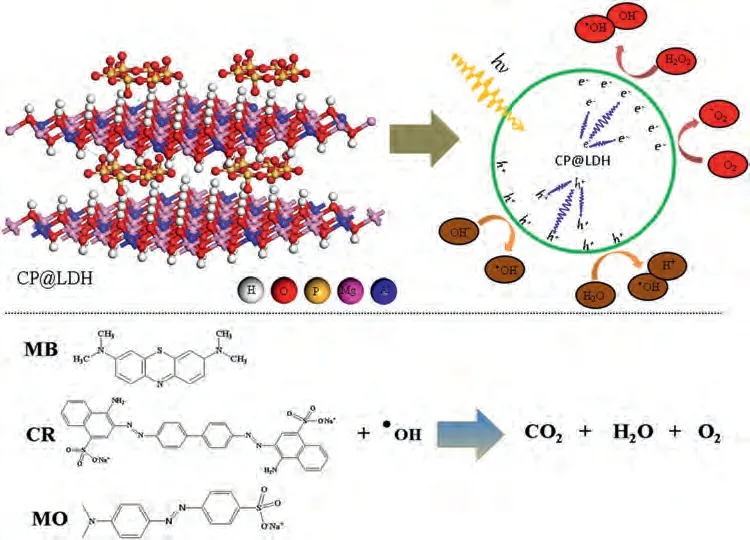
Fig.10.Schematic representation depicting the process of dye degradation,photon interaction with the photocatalyst leading to the generation of excitons,and their potential reactions.
The formation of electron-hole pairs plays a crucial role in the production of hydroxyl radicals.These electron-hole pairs act as catalysts,facilitating the interaction with initiator molecules such as H2O2,as described in Eqs.(16) and(17).This process results in the generation of additional hydroxyl radicals,which are highly reactive and contribute to the degradation of the target compounds.
Indeed,the electron-hole pairs generated on the catalyst surface can also give rise to hydroxyl radicals and hydroperoxyl radicals,originating from sources other than the H2O2initiator.This process is described by Eqs.(18)–(20).Water and dissolved oxygen present in the system can serve as precursors for these radical species when interacting with the catalyst’s electron-hole pairs.These radicals contribute to the degradation mechanism and further enhance the photocatalytic activity of the catalyst in the presence of UV irradiation.
Eqs.(16)–(20) represent several possible reactions occurring on the catalyst surface,leading to the generation of reactive hydroxyl radicals.Additionally,photolysis of the initiator molecule can also take place,as shown in Eq.(21):
These reactive hydroxyl radicals (OH·) play a significant role in degrading the dyestuffs (Eq.(22)):
The modified LDH films with separately incorporated CP and LP have demonstrated improved photocatalytic performance compared to LDH alone.Both CP and LP impart unique advantages to the LDH films,but CP exhibits superior photocatalytic efficiency compared to LP.The cyclic arrangement of CP offers enhanced stability,resistance to hydrolysis,and efficient charge transfer,which prevent undesirable side reactions and facilitate the rapid separation of electron-hole pairs,leading to increased radical species generation.The metaphosphate ring in CP exhibits notable resistance to hydrolysis,which can be attributed to the inherent stability of the hexametaphosphate ring structure,particularly in the vicinity of natural pH levels [53–55].Moreover,CP’s cyclic structure provides a higher adsorption capacity for organic pollutants,complementing the layered LDH structure during intercalation.The presence of more negative charge in the case of P6O186-anions compared to LP (P3O105-or/and PO43-) can indeed play a significant role in influencing the photocatalytic performance of modified LDHs.The additional negative charges on the P6O186-anions can lead to several effects that contribute to improved photocatalytic activity.First,the extra negative charges in the P6O186-anions result in increased electron delocalization across the anion’s cyclic structure.This extended delocalization can promote more efficient charge separation and reduce charge recombination,which are crucial factors for efficient photocatalysis.Second,the higher negative charge density in P6O186-anions can facilitate more efficient electron transfer from the anions to the LDH layers or to the reactant species,enhancing the generation of reactive species (e.g.,radicals) involved in photocatalytic reactions.Third,the presence of large and highly charged P6O186-anions in the interlayer space can cause significant lattice distortion in the LDH structure.This distortion might create additional defects and surface sites for enhanced photocatalytic activity.Finally,the higher negative charge in P6O186-anions may result in stronger electrostatic interactions with the positively charged LDH layers,potentially leading to better stability and reduced anion leaching during photocatalysis.In contrast,the lower photocatalytic performance observed in the case of the LP@LDH sample would be attributed to the fact that hydrolysis of LP anions might lead to occupying active sites or block certain surface regions of the LDH,reducing the availability of catalytically active sites for the photocatalytic reaction.During hydrolysis,the linear structure of P3O105-anions might be disrupted,leading to the formation of smaller,orthophosphate species with reduced negative charge density.These changes can affect the electronic properties,charge transfer,and overall photocatalytic activity of the LDH materials.
5.Conclusions
This study investigated the impact of condensed phosphates’ geometrical linearity on the photocatalytic performance of LDH nanoflakes for organic dye degradation.Two types of condensed phosphates,cyclic sodium hexametaphosphate (CP) and linear sodium tripolyphosphate (LP),were used as modifiers for LDH films.The novel approach of growing LDH nanoflakes on an AZ31 Mg alloy substrate via PE and subsequent phosphate modification led to significant improvements in photocatalytic efficiency.CP@LDH nanoflakes,with their cyclic structure,demonstrated superior performance compared to LP@LDH in degrading MB,CR,and MO under UV light exposure.The unique geometrical arrangement of CP@LDH likely enhanced surface reactions and catalytic interactions with organic dyes,contributing to its increased photocatalytic activity.The successful degradation of organic dyes using CP@LDH nanoflakes validates LDH-based photocatalysts as efficient and sustainable solutions for water detoxification.This research enhances our understanding of how condensed phosphates influence LDH nanoflakes’ photocatalytic behavior,providing valuable insights for designing optimized photocatalytic materials in various environmental and industrial applications.The synthesis approach demonstrated here offers a scalable production pathway for LDH-based photocatalytic coatings.Future research can explore different types and concentrations of condensed phosphates to fine-tune photocatalytic properties for specific pollutants.Further investigations into underlying mechanisms and reaction pathways will deepen our knowledge of LDH nanoflakes’ photocatalytic performance.
Declaration of competing interest
The authors declare that they have no known competing financial interests or personal relationships that could have appeared to influence the work reported in this paper.
CRediT authorship contribution statement
Mosab Kaseem:Conceptualization,Data curation,Formal analysis,Funding acquisition,Investigation,Methodology,Project administration,Resources,Supervision,Validation,Writing– original draft,Writing– review &editing.Ananda Repycha Safira:Resources,Software,Visualization.
Arash Fattah-alhosseini:Writing– original draft,Writing–review &editing.
Acknowledgments
This work was supported by the National Research Foundation of Korea (NRF) funded by the Korean Government(MSIT) (No.2022R1A2C1006743).The authors would like to express their gratitude to the Austrian Indonesian centre for Computational Chemistry(AIC)for providing the required software to conduct this work.
 Journal of Magnesium and Alloys2024年1期
Journal of Magnesium and Alloys2024年1期
- Journal of Magnesium and Alloys的其它文章
- Graphene–calcium carbonate coating to improve the degradation resistance and mechanical integrity of a biodegradable implant
- Degradable magnesium alloy suture promotes fibrocartilaginous interface regeneration in a rat rotator cuff transosseous repair model
- Stress-corrosion coupled damage localization induced by secondary phases in bio-degradable Mg alloys: phase-field modeling
- HVOF-sprayed HAp/S53P4 BG composite coatings on an AZ31 alloy for potential applications in temporary implants
- Greatly enhanced corrosion/wear resistances of epoxy coating for Mg alloy through a synergistic effect between functionalized graphene and insulated blocking layer
- Superplasticity of fine-grained Mg-10Li alloy prepared by severe plastic deformation and understanding its deformation mechanisms
